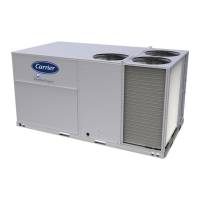6
SCROLL
+
-
NAVIGATE/
EXIT
MODIFY
SELECT
PAGE
C06322
Fig. 4 -- System Pilott User Interface
Force Hierarchy
There is a hierarchy in SystemVu controls with regards to forcing a
point. Programs and devices write a force at different priority
levels. A higher level (smaller number, 1 being the highest) will
override a lower level force. The SystemVu controller uses a
Control Force at level 7. The Navigatort device writes a Service
Force which is level 3. System Pilott and Touch Pilott devices
write Supervisor Forces at level 4. Network programs can be set to
write different level priority forces.
NOTE: In the case of a control power reset, any force in effect at
the time of power reset will be cleared.
IMPORTANT: All further discussions and examples in this
document will be based on the SystemVut controller.
START-UP
IMPORTANT: Do not attempt to start unit, even momentarily,
until all items on the Start--Up Checklist (see page 163) and the
following steps have been read/completed.
Unit Preparation
Check that unit has been installed in accordance with these
installation instructions and all applicable codes.
Refrigerant Service Ports
The refrigerant system has a total of 3 Schrader-type service gauge
ports per circuit. One port is located on the suction line, one on the
compressor discharge line, and one on the liquid line. Be sure that
caps on the ports are tight.
Cr ankc ase Heat er
The compr essor is equipped with a cr ankca s e he ater. There is a cont rol
function used to tur n the crankca se hea t ers on and off when the
com pressor is not running. This is a configurable value for whic h the
factory default value is set to 65_F. If the ambi ent is above t he selected
value the cont rol will pre vent the cr ankca se heater fr om tur ni ng on.
IMPORTANT: Unit power must be on for 24 hours prior to
start--up to allow the crankcase heater to run. Otherwise, damage to
the compressor may result.
Compressor Rotation
UNIT DAMAGE HAZARD
Failure to follow this caution may result in unit damage.
Improper wiring will cause compressor stoppage and alarm.
Correct wiring by switching leads as indicated below.
CAUTION
!
On 3-phase units , it is impor tant to be certain the compressors are
rotating in the proper dire ction. To de t ermi ne whet her or not
com pressors are rot ating in the proper direction, use a phase-rotation
me t er on the unit input power to check for L1-L2-L3 or clockwise
rotation or use the Ser vi ce Test mode to e nergize a compres sor. If the
com pressor is rot ating in the wrong di r ection, the c ont rols will stop the
com pr essor and di s play al arm for “Ci rcuit A Reve rse Rotation”.
NOTE: Indoor or outdoor fan rotation direction may not indicate
proper input power phase sequence, as some 3-phase units use
single-phase fan motors.
To correct the wrong compressor rotation direction, perform the
following procedure:
1. Turn off power to the unit and lock out the power.
2. Switch any two of the incoming unit power leads.
3. Turn on power to the unit.
4. Verify corrected compressor rotation.
Power Supply
All 208/230-v units are factory wired for 230-v power supply. If
the 208/230-v unit is to be connected to a 208-v power supply, the
transformers must be rewired by moving the wire from the
230-volt connection and moving to the 200-volt terminal on the
primary side of the transformer. Refer to unit label diagram for
additional information.
Internal Wiring
Check all electrical connections in unit control boxes; tighten as
required.
Evaporator Fan
The evaporator fan should be checked and may need to be adjusted
for specific applications. The unit will have a belt drive motor
powered by a Variable Frequency Drive (VFD). Refer to the unit
product data for Fan Performance tables and physical data.
The fa n bel t and variabl e pulleys are factory installed and se t, but ma y
need to be adjusted for specific applications. Check the fan to ensure
its rotation is in the proper direction before adjusting performance. T o
alter fan performance , fi rst a djust t he pul ley setti ngs to provi de t he
application’s ful l load des ign ai r flow when running at the IDF
Maximum Fan Speed (MAXI M UM IDF SPEED). The unit
operating speeds can then be adjusted with Free Cooling IDF Speed
(FREE COOL IDF SPEED), High Cooling IDF Speed (HIGH
COOL IDF SPEED), Medium Cooling IDF Speed (MED COOL
IDF SPEED), Low Cool i ng ID F Speed (LOW COOL I DF
SPEED), Heating IDF Speed (HEATING IDF SPEED),and
Ventilation Only IDF Speed (VENT IDF SPEED). Set the indoor f an
pulley to the gre ater a ppli cati on design point CFM for hea ting or
cooling and equal to 100% fan speed. Adjust the Heating Fan Speed
and High Cooling Fan Speed so that the CFM is not lower than the
minimum CFM allowed in the pr oduc t dat a. If the exa ct CFM cannot
be set by the half turn pulley settings then adjust the IDF Maximum
Fan Speed (MAXIMUM IDF SPEED) to fine tune the CFM to the
application require m ents. The VFD’s se ttings shoul d not be used f or
adjusti ng fan performance. Specifi c VFD inf ormation ca n be found in
the ma j or com ponents section.

